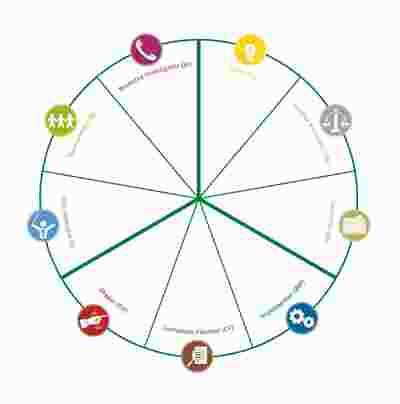Why is teamwork important?
An organisation is only as successful as its teams. In a complex, uncertain and fast-moving world, teams are the building blocks of organisation health – the key link between individual talent and business outcomes.
In short, building high performing teams should be amongst the key priorities of every business.
“It is not the individual but the team that is the instrument of sustained and enduring success.”
Antony Jay, foreword to 'Management Teams, Why they Succeed or Fail' by Meredith Belbin
Webinar: Using Belbin to form high-performing teams
During this webinar we start with the question 'what does a team need?' and look at how using Belbin - the gold standard team tool - can help increase the performance of teams.
In teams, people work concurrently, saving time and resources
A large body of research has demonstrated the need for teams within organisations.
A survey by EY discovered that almost 9 out of 10 companies “agree that the problems confronting them are now so complex that teams are essential to provide effective solutions”.
In addition, “an overwhelming majority of respondents think that their organisation’s ability to develop and manage teams will be essential for their future competitiveness”.
In teams, people work concurrently, saving time and resources.
Responsibilities are shared and individual team members are accountable to one another. Resources can be pooled, allowing teams to collate, organise, cross-reference and analyse information more effectively than individuals can.
Teams have the benefit of greater innovation too, because diverse individuals are able to share and develop ideas together. With knowledge shared in teams, organisations can learn – and document and retain that knowledge – more effectively.
Each of us will work as part of a team during our working lives. Yet, teamwork doesn’t always… work. Some teams gel and others don’t.
As Dr Meredith Belbin puts it:
“Simply putting together a number of people and expecting them to work as a team is not enough.”
Dr Meredith Belbin
Why I use Belbin for teams
"I do a lot of team coaching and at the moment. Quite a few teams have been asking me to come in and help them to become higher performers, and I found bringing in Belbin has been a fantastic way to look at the teams. To look at how they are conflicting with each other, looking at how they are complementing each other... People have actually said this has been completely life-changing for our teams."
For teams to be effective, they must have access to the tools needed for success.
Belbin works with teams to help each person understand their strengths in terms of nine Team Roles – nine distinct clusters of behaviour which are needed to facilitate team progress. Once people understand their Team Role strengths and weaknesses, they have a language that can be used every day at work.
The language of Belbin Team Roles allows managers to allocate work to the right people, put together effective working relationships and ensure that weaknesses are managed without impinging on the collective strengths.
In terms of employee development, it helps team members understand how they contribute to the overall team, how their behaviour impacts the team and how to boost the team’s overall performance.
Our reports, training, workshops and resources enable organisations to build stronger teams with a defined purpose, clear communication and greater effectiveness.
Case Study
GroupM used Belbin to win new business by unlocking the team’s behavioural diversity and improving collaboration.
“The Belbin profiling and coaching sessions helped us unlock our individual strengths and discover how we complemented each other as a team. As a result we not only won our new business pitch, but also an award for team values”. CEO

What is a high-performing team?
A high-performing team is a group of skilled individuals who are selected to work together to meet a common objective and share responsibility for outcomes.
Great teams have some key characteristics. They will:
- Share values and a vision
- Foster trust and psychological safety
- Value (and practise) effective, open communication and collaborating
- Be adept at problem-solving
- Possess complementary skills which enable diverse perspectives and approaches
- Consistently deliver outstanding results
Whatever the metric for high performance, all teams have the potential to perform better, given the right tools.

Find out more about the Belbin reports: The intelligence your team needs
Our personalised behavioural reports focus on the nine key clusters of behaviour (Team Roles) needed for team success. They help people to better understand their strengths, cultivate hidden talents and work more effectively together.
Belbin Individual report
The Belbin Individual report analyses an individual’s contributions in terms of the nine Belbin Team Roles, offering advice and guidance on how they might work best, announce their preferences to others and cultivate latent talents.
Belbin Team report
To build and cultivate great teams, team members need to understand, recognise and maximise the behavioural strengths of others, whilst managing and containing the associated weaknesses.
What makes an effective team?
No two teams are the same, but the characteristics of high-performing teams are universal. Understanding these attributes can help you to gauge where your team is and where it needs to go. The checklist below might help you. If you're looking to take your team to the next level, why not start a conversation?
- Purpose: If you were to ask everyone in the team to write down the team's objective, would they all write down the same thing?
- Role clarity: Does everyone understand the roles and contributions they need to play in the team?
- Adherence to agreed, established norms: How have the norms changed over the past two years? Are these explicit and apparent to new team members?
- Dynamic interaction: Are interactions solutions-focused and framed positively?
- Shared leadership: Is leadership shared according to strengths and aptitude?
- Psychological safety: Do all team members feel they can challenge and suggest ideas freely?
- Small size: Is everyone able to contribute and have their voice heard?
- Behavioural diversity: Is there a 'team culture?' Do you recruit for 'culture fit' or 'culture add'?
- Ability to handle conflict effectively: Can you predict potential conflict and do you have the tools to turn problematic relationships into powerful working relationships?
Looking at each characteristic in turn:

Purpose
A team must have a purpose that is clear, communicated and understood by all team members.
The first question when considering team effectiveness should be: “What is the team being set up to do?” Understanding this purpose can help you answer subsequent questions about the size and composition of the team, as well as how its success should be measured.
Successful team composition is concerned with ensuring that you have the right combination of skills, abilities and behavioural contributions present in the team to enable it to meet its objectives.
Role clarity
Members of high performance teams are chosen for what they can contribute and have a clear understanding of what is expected of them and others in the team. They are not bound by rigid job titles or definitions, but know how to work effectively within their remit and when to call on others within the team.
By contrast, role ambiguity can be detrimental to performance. This occurs when someone is unclear about expectations in terms of their tasks and responsibilities.

Adherence to agreed, established norms
Norms are the rules of engagement by which a team operates. Sometimes norms are implicit and longstanding and may not be fully understood by everyone in the team.
Discussing and establishing behavioural norms helps people focus on team values, promotes understanding of others’ behaviour and establishes to understand the boundaries of acceptable and unacceptable behaviour within the team.
How have the norms changed over the past 2 years? Are these explicit and visible to new team members?
At Belbin, we help you every step of the way
Whether you would like one of our experienced facilitators / consultants to work with you and your teams, or if you would like to become a Belbin expert, we can help.
Whatever your reasons, we can help you, and your team.
We look at the issues that are specific to your organization, and the people within it. Then, using the Belbin theory, we build a bespoke workshop specifically designed to address the issues that you are facing.
Using a Belbin facilitator ensures that everyone can participate and maximize their contribution. We facilitate sessions with teams at all levels, from boards of directors to new recruits.
Position yourself as a certified Belbin expert.
Belbin accreditation is recommended for anyone who uses – or wants to use – Belbin Team Roles as part of their training toolkit.
Whether you're an HR, L&D or training professional, or an independent facilitator, coach or management consultant, Belbin accredited certification will give you a solid grounding in Belbin theory, and confidence in delivering report feedback and team workshops.
Dynamic interaction
Effective communication is crucial to team success. It is key to engagement and performance, and it is shown to reduce stress and conflict. In high performing teams, team members are able to communicate effectively and are not restricted by hierarchical considerations.
“Without open, explicit communication about tools and processes, individuals have trouble making clear to one another what they are doing.” Rhodes, 1991

Dr Belbin’s research studied teams in action, coding and documenting the exact nature of their interactions every thirty seconds over the course of a team exercise. The nine Team Roles were discovered as a result of these observations.
“Making people aware of their own strengths results in better communication among team members and thus higher levels of performance.” Harvard Business Review
Belbin Team Roles help individuals identify their behavioural strengths, so they can better understand how to contribute to the team as a whole, and when to ask other team members for help.
Team Role theory is used in organisations worldwide to help teams communicate more effectively and to surmount hierarchical boundaries which prevent teams from attaining their best performance.
We'd like to find out more about the problems you and your teams face. Whatever the problem, we'd love to explore ways to help turn your existing team into a high-performing one.
Click here to start the conversation.

Shared leadership
Leadership within the team should be rotated, depending on where the team is in relation to the business objective.
Belbin enables teams to excel in project management by helping them to identify which team members are needed at each stage of a project and giving individuals the confidence to act as team leader when appropriate, and to lead according to their strengths.
Psychological safety
Google’s Project Aristotle found that, in order to succeed, team members need to feel safe to take risks and make mistakes without fear of recrimination. Whilst trust exists between individuals, psychological safety is a team construct.
Stressful situations prompt our fight, flight or flee response, which inhibits both our perspective and our reasoning abilities. Within a team, the stakes are higher still. In primal terms, being rejected from a group could mean struggling to find resources alone—a fight for survival. But whilst our evolutionary drive is to crave acceptance and nod along, the world of business needs us to speak out when things go wrong, adapt, take risks, fail and grow together.
Without psychological safety, a team is likely to founder. If people don’t feel able to speak out, it takes longer for mistakes to be identified. Conflicts which might be aired and resolved are allowed to fester. Or perhaps the team becomes embroiled in long-term strategies that ultimately fall foul of the ground moving beneath our feet.
By contrast, we become more open-minded, creative and resilient when we feel safe. We allow ourselves to think laterally and we’re more likely to keep a sense of humour when things go wrong.
This webinar was part of The Institute of Leadership Webinar Series.
Over the past two years, Belbin have worked with teams who have been at the norming, forming, storming and performing stages of team development… and everything in between. Remote and hybrid working have highlighted a number of challenges in team performance.
During this webinar we look at five 'must haves' to empower and engage your teams for 2022, wherever they're working.
Cultivating behavioural diversity
Teams where everyone thinks in the same way are likely to be collegiate, but homogenous teams tend to lead to groupthink and neglect opportunities and perspectives other than their own. Whilst cohesion may seem like a positive, the pressure to conform to a group can mean that team members switch off their critical faculties in the interests of consensus with the group.
Over time, teams can develop a culture which rejects newcomers with different ideas and approaches. Team problems can become entrenched and the reasons (and solution) are not obvious to those within the team.
Whilst it may feel uncomfortable to admit those with very different perspectives to our own, it is the safest way to guard against stagnation in a team. When a new team member is introduced to a cohesive team, it is important to manage integration and potential conflict.


Handling conflict effectively
Conflict often arises from misunderstanding or lack of communication. It can manifest itself in many ways. Lowered morale, reduced productivity and increases in absenteeism can all be strong indicators that something needs to be addressed.
Sometimes teams become too inward focused and forget their role within the larger picture. Teams can start to compete with other teams, or start dismissing other team's suggestions and outputs. This can lead not only to cross-team conflict, but to reduced productivity within organisations. However, conflict is essential for teams. Professor Richard J. Hackman’s research found that disagreements were good for a team, so long as they were handled in the right way and focused on the team’s objectives.
Belbin is useful in areas where discussions can too often include personal attacks and can often exacerbate the problems. The language of Team Roles depersonalises conflict, helps team members to understand and appreciate diverse viewpoints, and refocuses them on how best to achieve their objectives.
Size
One of the fundamentals about teams (that is largely ignored by a lot of coverage on teams) is that size matters. Teams should be limited in size, since they should only contain people that have been actively selected for what they can contribute to the team at a given time. And people in the team should change – teams should be fluid and reactive, changing to ensure they achieve whatever it is they set out to do.
Meredith Belbin's ideal team size is four.
“Small teams can deliver results faster, engage people better, and stay closer to their mission.”
Ernst and Young, May 2013
This number ensures the team members will have equal(ish) input, airtime, responsibility and actions.
There shouldn't be any duplication of roles (functional or team) and decision-making will be less drawn out. An even number means that agreement has to be reached – no one person has the casting vote.
Groupthink is less likely to happen. People are more likely to challenge, discuss problems openly, and arrive at appropriate solutions.
Whilst there are nine Team Roles, high performing team members can make a positive contribution using more than one Team Role.
In general, we tend to find that we can play all nine Team Roles, but we have real strengths in two or three, can manage an additional two or three and have two or three roles that are best delegated to someone with the relevant strength. This means that a team of four, if put together with care, should cover all nine Team Roles.

As numbers increase, the team's narrative changes:
- Four: "We’re well-balanced in our team and good at achieving agreement."
- Five: "One of us tends to be the odd one out."
- Six: "It takes longer to reach agreement, but we get there in the end."
- Seven: "Rather too many random contributions float about."
- Eight: "People speak freely but no one listens."
- Nine: "We could do with someone taking control."
- Ten: "We now have a leader, but their ideas are the only ones with a chance of acceptance."
“If I see more than two pizzas for lunch, the team is too big.”
Jeff Bezos, Amazon CEO
Conclusion
There are a number of interconnected factors which enable effective team performance.
Even for highly effective teams, consistency of performance is not a given and frequent, regular work is needed to keep teams working to their full potential.
Belbin Team Roles is proven to help build relationships, clarify objectives, address conflict, delegate work, help leaders and support real teams.
We'd like to find out more about the problems you and your teams face. Whatever the problem, we'd love to explore ways to help turn your existing team into a high-performing one. Click here to start the conversation.

Useful reading for you and your teams

Article
Six Common Teamwork Myths put Straight
Professor J. Richard Hackman wrote an article outlining “Six Common Misperceptions about Teamwork”. Here, we revisit his findings and explore them in a little more detail from a Belbin perspective.

Article
Belbin and Tuckman
Tuckman studied teams from formation to completion of a task and identified characteristics of each stage of team development – forming, storming, norming and performing. How does team development fit with Belbin Team theory?

Article
Using Belbin to build psychological safety in teams
Psychological safety. Put simply, it’s the idea that, in order to succeed, people in teams need to feel safe to take risks and make mistakes without fear of recrimination.